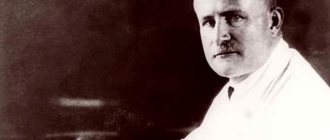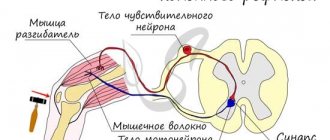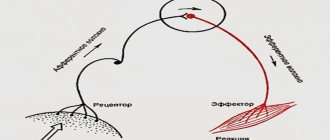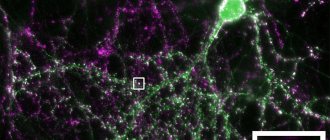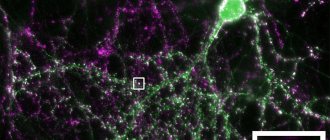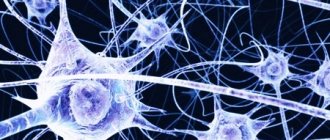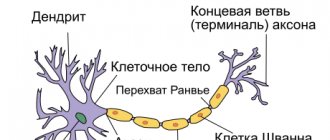Author: TainT
October 27, 2021 12:14
Community: Science
Tags: macro photography science neuroscience photo it's interesting
6375
22
The brain is a whole universe. What is there, what is being done and how it all works today we can see with the help of a microscope and macro photography. Let's lift the curtain and take a look into this wonderful world.
0
See all photos in the gallery
"Snail" of a newborn rat
0
This stunning image, which took eighth place in the 2021 Nikon Small World competition, shows us the main organ through which we hear: the snail. Hair cells are shown in green, the deviation of which triggers a nerve impulse that ultimately arrives in the auditory cortex. Red - nerve cells of the cochlea, “collecting” signals from hair cells.
Information processing by neurons
So what allows us to limit ourselves to studying simplified neurons? Perhaps the most compelling argument in their favor is the success of neural network models that have used simplified neurons over the past few decades. Artificial neural networks have been used to model many brain functions—recognizing visual elements, controlling robots, learning, and improving functioning based on experience.
Most models based on artificial neural networks are relatively small in scale and have limited functionality. None of them even approach the complexity of the brain.
The history of science has many examples of how new mathematical methods helped solve hitherto insoluble problems. Neural networks also help us understand the functioning of the nervous system.
The mathematical basis of neural networks has improved significantly since their inception. There appears to be a fairly limited set of underlying architectures analogous to brain networks.
Neuroscientists are primarily interested in those neural networks that are based on the known properties of groups of neurons and connections between them. Thus, artificial neural networks can serve as models for studying real structures in the brain.
In addition to the simplified neuron, we will also use the simplified synapse . As already mentioned above, we will limit ourselves to considering synapses of only two types - excitatory (increasing the probability of the passage of an action potential on the postsynaptic neuron) and inhibitory (decreasing this probability).
Glutamate , the most common neurotransmitter in the central nervous system, is excitatory. GABA ( gamma-aminobutyric acid ) is the most common inhibitory neurotransmitter. Thus, our simplified model still reflects a certain part of the real picture.
Dividing neuronal stem cells
0
The skin, liver, heart, kidneys, lungs and blood can form new cells to replace damaged ones. Until recently, experts believed that this ability to regenerate did not extend to the central nervous system, consisting of the brain and spinal cord. However, over the past five years, neuroscientists have discovered that the brain does change throughout life: new cells are formed to cope with emerging difficulties. This plasticity helps the brain recover from injury or disease, increasing its potential.
BASIC PROPERTIES OF NEURONS
The main properties of neurons: irritability, excitability, conductivity, lability, inertia, fatigue, inhibition, regeneration, etc.
Irritability is the ability of a nerve cell to respond to various irritations with biochemical changes, accompanied by a violation of ionic equilibrium and depolarization of electrical charges on the cell membranes at the site of irritation. Irritability is inherent in all cells, and especially nerve cells associated with the sensitive perception of smell, sound, light and other stimuli. Irritability is a trigger for the manifestation of another property - excitability.
Excitability is the ability of individual parts of a nerve cell to generate electrochemical impulses, that is, to respond to stimulation with excitation. For a nerve cell to transition into a state of excitation, it is necessary that the strength of the current stimulus reaches a critical limit - a threshold value. The ability of a neuron to respond with excitation to the smallest stimulus strength is called the lower threshold of excitability. The more sensitive a nerve cell is to stimulation, the lower the threshold of excitability, and, therefore, even the weakest stimulus can cause excitation. The amount of excitation of a neuron depends on the strength of the stimulus and increases according to the law of force relations up to a certain limit - the upper threshold of excitability. The use of stimuli of suprathreshold strength creates extreme inhibition in the neuron, which protects the nerve cell from overexcitation.
A single stimulus usually causes a series of impulses of a certain strength, duration and frequency. In different nerve cells, the frequency of impulses is different - from 100 to 1000 per second. The strength and duration of excitation impulses depends on the nature of the irritation.
Conductivity is the ability of a neuron to conduct excitation impulses at a certain speed, in a constant rhythm and strength. Excitation along the nerve fiber can spread in both directions from the irritated area. In different nerve cells, the speed of excitation is not the same and depends on the physiological state of the neuron and the thickness of the fiber. In sensory neurons, excitation propagates at a speed of 100–120 meters per second, in motor neurons – 60–100, and in the autonomic nervous system – 5–7.
Lability (mobility) is the ability of a nerve cell to receive and transmit the maximum number of impulses per unit of time without distortion. The mobility of motor neurons is no more than 500 impulses per second. Lability ensures the directed distribution and conduction of excitation impulses of the desired frequency along certain nerve pathways. In the process of growth and development of the body, as well as with systematic training, lability increases and ensures the dynamism of the nervous system; with fatigue and aging, it decreases.
Inertia is the ability of a nerve cell to accumulate and store traces of excitation and inhibition. The information received is deposited in dendrites, cell soma, and nuclear chromosomes in the form of biochemical changes in plasma DNA and RNA. This property of neurons provides the body's memory, which is crucial in the learning process of animals.
Fatigue is a natural process of decreased cell performance due to prolonged excitation or inhibition. It manifests itself in the form of a decrease in the strength of excitation, a slowdown in the frequency of the rhythm of impulses and the speed of their conduction. Rest of nerve cells or change of nervous activity relieves fatigue, and all properties are restored.
Inhibition is the opposite process to excitation. Consists of weakening, stopping or preventing the occurrence of excitation. Inhibition is an active process, spreading through nerve cells, it ensures the coordinated functioning of individual organs and the entire organism as a whole.
Regeneration is the ability of a nerve cell to restore lost or damaged processes through germination. Nerve cells do not reproduce, dead neurons are not restored. Nerve cell fibers are able to germinate if the cell body is preserved.
Immune cells heal brain after bleeding
0
In a new paper in Nature Communications, Houston neuroscientists show how immune cells called neutrophils can repair the brain after a hemorrhagic stroke. Neutrophils are known as the "infantry" in the body's war against infection. It turns out that they have another function: a new study shows that these immune cells may play a crucial role in protecting the brain from stroke, and can also be used in the treatment of intracerebral hemorrhages.
Neural theory of brain structure
The neural theory suggests that the central nervous system has a cellular structure. Nervous tissue cells - neurons, are structural and functional elements of the central system. Depending on where in the nervous system neurons are located, they perform different functions. The brain is a highly organized organ.
Command cells control executive cells. Nervous activity is the result of interaction between the elements of the system. The neurons that make up the brain are the elements of the system that organize reactions in response to stimuli, which causes the appearance of standard reflexes.
Cerebellar granule cells
0
Here is a snapshot of the cells of the granular layer of the cerebellum. Granule cells are small neurons, about 10 micrometers in diameter.
0
In the vast majority of cases, the cause of vision loss is the death of a large number of photoreceptor cells in the retina, which convert light into electrical nerve signals. Retinal cells that are insensitive to photons remain intact.
Types of neurocytes
Neurocytes are the second name for neurons. Outside the brain structures of the central nervous system, they are located in ganglia, which are nerve nodes (spinal, cranial nerves, related to the autonomic system). Depending on the functions performed, the cells of the nervous tissue are sensitive, associative, effector, secretory. The first receive signals coming from the peripheral zones of the nervous system.
More often the signals are directed to the brain, less often to the cells of the autonomic ganglion. Sensitive cells are small in size and have a large number of dendrites. Associative cells conduct signals within the neural network, providing communication between sensitive and effector cell types. They are located in the brain (brain, spinal cord) and autonomic system. In all cases, they are elements that close reflex arcs (groups of neurons connected by synapses).
Effector neurons are motor neurons that move parts of the human body. Effector neurons conduct signals to executive organs, including skeletal muscles, which determines human motor activity. Effector cells are large cells equipped with rough, less branched processes. Secretory cells produce neurohormones.
Do nerve cells recover?
For a long time it was believed that neurons are not capable of division. However, this statement, according to modern research, turned out to be false: in some parts of the brain, the process of neurogenesis of neurocyte precursors occurs. In addition, brain tissue has remarkable abilities for neuroplasticity. There are many cases where a healthy part of the brain takes over the function of a damaged one.
Many experts in the field of neurophysiology have wondered how to restore brain neurons. Recent research by American scientists has revealed that for timely and proper regeneration of neurocytes, there is no need to use expensive drugs. To do this, you just need to create the right sleep schedule and eat right, including B vitamins and low-calorie foods in your diet.
If a disruption occurs in the neural connections of the brain, they are able to recover. However, there are serious pathologies of nerve connections and pathways, such as motor neuron disease. Then it is necessary to turn to specialized clinical care, where neurologists can find out the cause of the pathology and formulate the correct treatment.
People who have previously consumed or are drinking alcohol often ask the question of how to restore brain neurons after alcohol. A specialist would answer that for this you need to systematically work on your health. The range of activities includes a balanced diet, regular exercise, mental activity, walks and travel. It has been proven that the neural connections of the brain develop through the study and contemplation of information that is completely new to humans.
In conditions of oversaturation with unnecessary information, the existence of the fast food market and a sedentary lifestyle, the brain is qualitatively susceptible to various damages. Atherosclerosis, thrombotic formation on blood vessels, chronic stress, infections - all this is a direct road to brain clogging. Despite this, there are medications that restore brain cells. The main and popular group is nootropics. Drugs in this category stimulate metabolism in neurocytes, increase resistance to oxygen deficiency and have a positive effect on various mental processes (memory, attention, thinking). In addition to nootropics, the pharmaceutical market offers drugs containing nicotinic acid, agents that strengthen the walls of blood vessels, and others. It should be remembered that restoring neural connections in the brain when taking various drugs is a long process.
Receptive fields and lateral interactions
The lateral inhibition hypothesis was first proposed by the German physicist Ernst Mach in the 1860s. based on the fact that holistic visual gradients were perceived as broken. This hypothesis was brilliantly confirmed by direct experiments.
Lateral inhibition occurs in many brain systems. In the retina, neighboring cells inhibit each other, so that a bright dot is clearly perceived against a dark background.
When touched, adjacent skin receptors also exhibit lateral inhibition. At higher levels of brain organization, similar semantic structures inhibit each other, which is why we do not confuse the words “astronomy” and “astrology.” Like many of the other neuronal mechanisms discussed in this chapter, this mechanism emerged early in evolutionary history and has since been repeated many times in many systems.
Lateral interactions. Often the same strategy is used in different areas of the brain. On the left is the center-periphery receptive field of the lateral geniculate body. Light falls into the red spot area in the center, but not into the surrounding ring.
Neurons respond to both of these facts and enhance the contrast through mutual inhibition in the same layer, called lateral inhibition. A similar mechanism is used in the central receptive field as well as in the cortical columns of the rat, each of which processes sensory input from a single vibrissa.
For this reason, columns are often the object of study when studying such processes. Neighboring vibrissae have an inhibitory effect on each other, which also occurs in areas of the human brain that process sound and tactile information, as well as in the area that controls attention.

